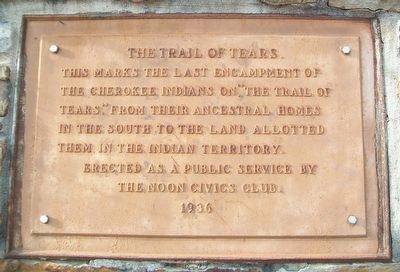Trail of Tears Monument
Introduction
Text-to-speech Audio
Images
A picture of the monument by William Fischer, Jr. on January 17, 2016.

The inscription of the monument by William Fischer, Jr. on January 17, 2016

Backstory and Context
Text-to-speech Audio
To Eastern Americans, particularly those in the west, Native Americans were foreign, and therefore something to be feared and resented in their eyes. For a long time, the land that they had inhabited for years was seen as desirable, but the claimed “Indian Problem” was debated in how to best deal with the Native Americans. Some, such as George Washington, said that the best method was to “civilize them,” or rather, to make the Native Americans behave in manners that were like European customs. This meant converting them to Christianity, teaching them English, and practicing European economics. Some members of the Choctaw, Chickasaw, Seminole, Creek and Cherokee tribes would conform to this, becoming known as “The Five Civilized Tribes.”
Regardless of how “civilized” these people were in some eyes, there were others that still despised them and desired Native American property for its value. Native American livestock would be stolen, houses burned to the ground, and mass murders would ensue throughout Georgia, Tennessee, Alabama, North Carolina and Florida. Eventually state governments would come to aid in Native American removal by passing laws stripping them of their rights and liberties, and although these were fought against, such treatments would endure. President Andrew Jackson, who had long been a fan of removing Native Americans would eventually sign the Indian Removal Act in 1830, and in 1831, against the laws stating that the Native Americans needed to agree to the terms peacefully, he would send his government to threaten them to leave. The Choctaw were the first to be forced away, a journey entirely on foot with no food, supplies, or help from the government, and thousands would die. Next would be the Creeks in 1836, where 3,500 of the 15,000 who left for the journey would not survive.
The Cherokee were divided on the best method to resolve the issue. Some felt that they should remain and fight, while others believed that they could come up with a deal that would prove to be favorable to them. In 1835, some self-appointed representatives of the tribe made a treaty with Congress to leave in exchange for five million dollars, relocation assistance, and compensation for lost property. Congress agreed, however, many Cherokee felt that this was an act that did not properly represent their people, and nearly 16,000 would sign a petition saying this. Congress would ignore this plea, however, and President Martin Van Buren would send General Winfield Scott and 7,000 soldiers to remove the Cherokee people. Cherokee houses were pillaged by the soldiers, and then the Cherokee would be marched over 1,200 miles by bayonet across the Mississippi River. Whooping cough, typhus, dysentery, cholera and starvation were all major concerns to the Cherokee who received no aid and had no supplies, and 5,000 would die as a result.
Tens of thousands of Native Americans would be removed from their homeland by the 1840’s with thousands more dying along the way. What little territory they were given continued to decrease and decrease, and with the creation of Oklahoma as a state in 1907, all Native American territory would be removed despite the federal government’s promise to leave their land alone. The Trail of Tears marker within the last camp for the Cherokee would be created in 1936 by The Noon Civics Club as a constant reminder of the journey that so many were forced to make.
Sources
History.com. Accessed November 04, 2018. https://www.history.com/topics/native-american-history/trail-of-tears.
"History & Culture." National Parks Service. Accessed November 04, 2018. https://www.nps.gov/trte/learn/historyculture/index.htm.
"The Trail of Tears - The Indian Removals." Ushistory.org. Accessed November 04, 2018. http://www.ushistory.org/us/24f.asp.
"The Trail of Tears Historical Marker." Historical Marker. June 16, 2016. Accessed November 04, 2018. https://www.hmdb.org/marker.asp?marker=92345.
